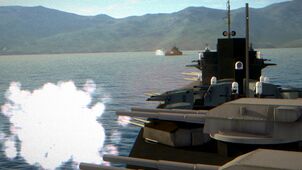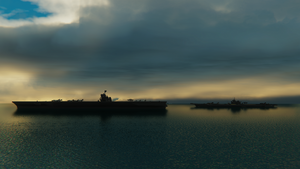North Point Campaign
|
North Point Campaign
Part of the War of Imperial Reclamation
|
|||||
|---|---|---|---|---|---|
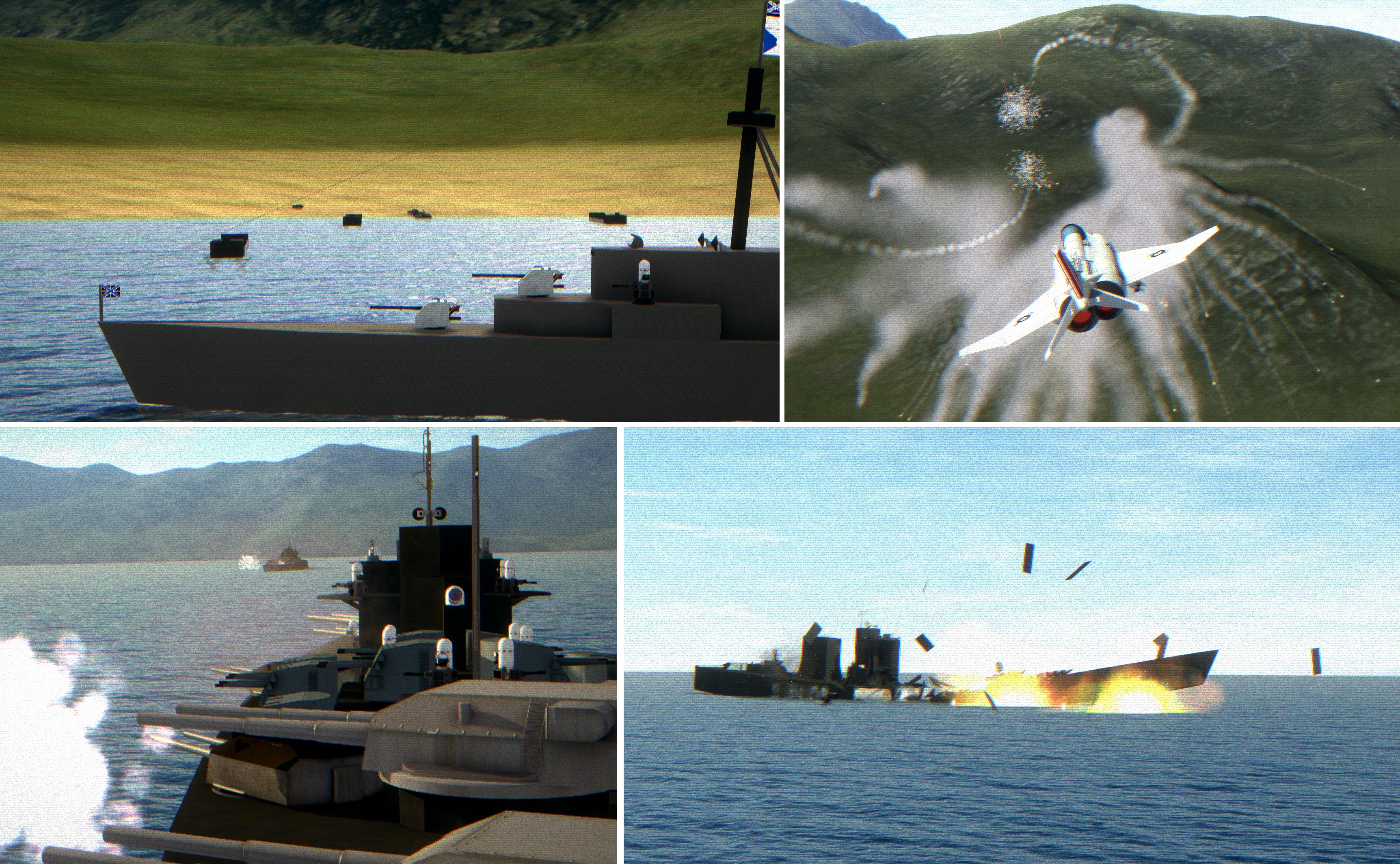 |
|||||
| Location | North Point, Arcadia | ||||
| Result | Coalition Victory | ||||
| Territorial Changes | Arcadia expelled from North Point | ||||
| Belligerents | |||||
| Arcadian Front | Reclamation Coalition | ||||
| Ultranationalist Arcadia | Imperial United Front Nautilus-Laveska Zokesia Arcovdonia Phoenia Belka Stahl Sieg volunteers |
||||
| Strength | |||||
| 2 Carriers 10 Battleships 40 Offshore Patrol Vessels 110 Motor Torpedo Boats 130 Aircraft 50 Main Battle Tanks 15 SAM sites 40 Coastal Gun Batteries |
6 Carriers 14 Battleships 16 Destroyers 32 Landing Craft 192 Aircraft 264 Main Battle Tanks 75 Ainti Air Artillery |
||||
| Casualties and Losses | |||||
| 1 Carrier 9 Battleships 30 Offshore Patrol Vessels 110 Motor Torpedo Boats 120 Aircraft 50 Main Battle Tanks 15 SAM sites 40 Coastal Gun Batteries |
7 Battleships 3 Destroyers 76 Aircraft 50 Main Battle Tanks 1 Battleship Damaged 1 Destroyer Damaged |
||||
The North Point Campaign, also known as Operation Carolinas and the 1st and 2nd Naval Battles of North Point, was a series of battles fought in the Tau Sea during February and March 2148, at the start of the War of Imperial Reclamation the combined forces of Zokesia, Laveska, and Imperial United Front launched Operation Carolinas, a mission to strike at the island of North Point, Arcadia. Although the Coalition suffered severe losses during the campaign, it was a strategic Coalition victory. It inflicted proportionately higher losses on Arcadia's navy and the control of the islands of North Point and Psylets in approximately 6 weeks of fighting.
Background
When the first signs of the UIF return coming in the form of massive spacecraft from Eve, the Zokesian government went on high alert. The Imperial Continuity Army and Nautilus-Laveskan Commonwealth soon came to a summit to reform the UIF and reclaim their homeland from the Arcadian Ultranationalists, who had led a brutal anti-imperium propaganda campaign for decades in the former Aenian states. War broke out in 2147, and soon all Zokesian naval assets were directed towards the Tau sea to support the UIF's naval assets in the region and contain Arcadian sea assets, in preparation for a land campaign on Arcadia proper.
Operation Carolinas
At 00:45 the night of February 12th, 2148, the combined forces of Zokesia, Laveska, and Imperial United Front launched Operation Carloinas, a mission to strike at the island of North Point, Arcadia. The operation was launched primarily from Sur-Krakain, with support from the Combined Fleet, consisting of Belkan, Laveskan, and Phoenian naval assets.
As the Combined Fleet set sail to hunt down the Arkadii-Soyuz task force, the northern fleet left harbor and sailed for two days before splitting off into two groups - the CV-21 Emperor Zeroth and the CV-04 (UIF) Fort Grace rendezvousing directly north of the island, with an escort force of four Laveskan destroyers. The rest of the fleet turned south, a combined force of eight Laveskan destroyers, four Zokesian battleships, and thirty-two Heavy Landing Craft, with the Zokeisan 1st and 2nd Marine Divisions aboard, the 3rd Marine Support Division, the 12th SS. Grailjungend, 14th SS. Belasrien, 17th SS. "Morado" Nautilen, and 19th SS. Arkerien - 180 Main Battle Tanks and 75 Support Units in all. To the South of the invasion fleet, the 1st Belkan Fleet shoots the gap of North Point and Arcadia main, acting as a quick reaction force should large-scale fleet action occur in response to the landings. Stationed just 40km from the landing site, the 1st Belkan Fleet will respond to any surface engagement the convoy should come under, and prevent reinforcement of naval assets to harass the landing force once it arrives onshore. As the force began bearing down on the island, the destroyers took up flank positions port and starboard, in line astern, and the Zokesian battleships in turn made another line astern on the starboard side of the landing force. Steaming due south, the four lines went - destroyer, battleship, landing craft, destroyer. These were the most dangerous times for the force as detection meant a surface engagement before the landing craft were in their final run-in ashore. Above them, a dozen anti-ship Kargadans from the carriers were on station, as well as another dozen on combat air patrol.
Unbeknownst to the Arcadians, the operation may well have been detected earlier - but from out of orbit, the Munar Marines dropped from orbit like fiery angels onto the rocky mountains in the northwest of the island, where a key long-range radar site overlooking the Tau sea was built. Taking the radar dish was their priority, as it would leave Arcadia blind to incoming threats, as the island blocked the mainland's early warning radar from the northwest sector of ocean. The marines landed under sporadic ground fire and managed to secure the radar site, but the defenses of the island were alerted and surprise had been lost. Now, Arcadian high command knew there was a threat on North Point and was ready to respond, early warning radar or not. Upon landing on North Point the UIF Marines were immediately engaged in a heavy battle with the island's defenders. Their primary mission, the radar tower overlooking the Tau Sea, had been eliminated after several hours of fighting, and now the task was upon them to head south and attempt to take the hard surface of NAS Stihland, the largest runway in 100km, situated in the southern part of North Point. Fighting their way through was hard going, and they would not make it without the reinforcement by sea.
Upon landing on North Point the UIF Marines were immediately engaged in a heavy battle with the island's defenders. Their primary mission, the radar tower overlooking the Tau Sea, had been eliminated after several hours of fighting, and now the task was upon them to head south and attempt to take the hard surface of NAS Stihland, the largest runway in 100km, situated in the southern part of North Point. Fighting their way through was hard going, and they would not make it without the reinforcement by sea.
The Battle for North Point
On Task Force 17, Rear Admiral Hamilton Thratcher faced troubling news. Earlier in the day, the large screening force of Belkan 1st fleet located and engaged with the Arcadian North Fleet within gun range and with fighter aircraft. The ensuing battle saw heavy losses in the air on both sides. After just minutes of gunfire, the three Belkan "Eminent Domain" Superbattleships were in flames, on their way to the bottom of the sea. The remaining Belkan "Orion" Class battleships turned tail and fled in humiliation. Reports on radar and from reconnaissance aircraft alerted Thratcher to the troubling news - not only was their screening force sunk or running, but a large detachment of motor torpedo boats and two Natalia-Class battleships were now heading for an intercept of the landing force. The only thing standing between the task force and the incoming might of the Arcadian North Fleet was the aircraft of the Emperor Zeroth Supercarrier and the venerable old Fort Grace. The Kargadan force of 16 strong tasked with covering Task Force 17 now were re-routed to intercept the ships, and a second wave of forty Kargadans were fueled and armed with anti-ship weapons. Bearing down on the battleships, they launched missile after missile, dodging anti-air fire that blanketed whole sheets of airspace. The first Natalia-Class took a direct hit amidships and began to roll over and sink, but the second one took Kaliber after Kaliber. It began to look like she was going to survive, when suddenly a flash erupted from the C-turret, and in the blink of an eye the ship was split in two, its bow and stern rising out of the sea as water poured into the flooded sections. Within seconds, the ship was headed to the bottom. The torpedo boats were no match for the F-52C's E57B "Ebb" radar guided missiles, and they soon followed the Natalias into the sea. The first engagement with Zokesian and Arcadian forces had been a stunning success.
But the task force still faced a massive roadblock - the rest of the Arcadian North Fleet was directly in the path of the landings and with only four battleships and less than half a dozen destroyers, TF17 could not possibly hope to break through without heavy losses and there was still the monumental task of landing under the guns of coastal batteries that had to be accomplished. Rear Admiral Thratcher made a fateful decision - to land not at the primary landing zone but another suitable location that was not in the guns of the Arcadian fleet. Scanning over maps and charts of the waters around North Point, Thratcher discovered a shallow bay in the northeast of the island - on the wrong side of the massive mountains that divided the island but gentle enough a slope to land the whole of the invasion force. Only 5 batteries covered the area and it was in the opposite direction of the Arcadian fleet. if the Arcadians wanted to take out the landing force they would have to sail up into the path of the Air Corridor set up for land operations and face the full brunt of Zokesian and UIF carrier based aircraft. The task force's commanders were briefed on the deck of the ZNS Kercia, Thratcher's flagship, and the group turned north away from the Arcadians twoard their new landing site. Reaching the beach hours later, Rear Admiral Thratcher ordered a shore bombardment of the coastal batteries to pave the way for the landing craft to be able to come ashore without coming under fire. The battleships Kerffinger and Rommel were tasked in the lead of the column, with Kercia and Osyrus remaining in reserve; the landing beach was flanked on the left by rolling hills, and on the right a steep slope that jutted out into the bay a half mile, and there would not be room for four battleships to maneuver in the space without risking collision when turning away from the beach after bombardment. Kerffinger and Rommel bore down from north of the landing zone and began opening up on the shore batteries. Zokesian intelligence reported the bunkers were made of flimsy steel and concrete and would not hold up to a battleship's firepower, and had elected to take them out without air support from carrier aircraft to preserve numbers for anti-ship strikes. This proved to be a fatal underestimation, and as Kerffinger and Rommel came under fire from no less than five 12" batteries it became apparent the bombardment was not suppressing nor destroying any of the gun emplacements. The shore batteries fire was accurate and focused, as the Arcadian commanders ordered their guns to all fire on the lead ship, the Kerffinger. She began taking hit after hit, but it seemed as if the battleship would survive the fullisade; the guns were smaller caliber and less numbered than the ones faced in Sahr and the venerable Morser class was known for taking huge amounts of damage and surviving. After 20 minutes of pitched battle, Kerffinger began to list starboard, and was down in the bow nearly 5 meters, more and more each passing minute. From the Rommel, the crew watched in horror as their sister ship and over a thousand sailors began to roll over, guns facing skyward blankly. Within 30 seconds, only the still spinning propellers were sticking out of the water, and in a few minutes they were gone too - the Rommel veered starboard out of line and away from the shore to avoid the massive oil slick and fire that once was Kerffinger.
Stunned, Rear Admiral Thratcher ordered Rommel to break contact and called the commander of the Emperor Zeroth, Captain James Barlkey, for air support. The Laveskan destroyers supporting the landing force were ordered forward to continue pounding the batteries, and within 20 minutes five Kargadans reached North Point airspace and began suppressing the shore bunkers. For over an hour, Laveskan destroyers and Kargadans rained down gunfire, missiles, and bombs, until finally all five batteries went silent. The beach was now open, but it came at a heavy loss - only 23 survivors from Kerffinger were found, the vast majority of her 1106 man crew going down with the ship, unable to escape as the ship rolled over in its final seconds. It was a day of mourning for the Task Force, but work was to be done. The mission had to continue, or their lives were lost in vain.
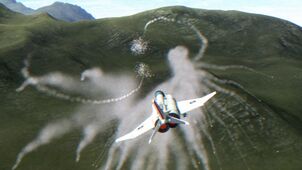
Thirty-two landing craft of the Zokesian Marine Corps and Stahlsieg bore down on the beach. Gunfire from shore defenders was light to nonexistent, and as the first boats' doors swung down the tanks of the Zokesian 1st and 2nd Marine Divison piled out and began engaging defenders in a push to establish a beach head. For the first time since the Civil War, Zokesians and Stahl Sieg fought side by side - against a common enemy - driving five miles along the coast, skirting the mountain range, before they began engaging Arcadian Armor. Of the 180 tanks landed, 50 would not survive the engagement - in one of the bloodiest tank battles since the Burr war, the drive to link up with the Space Marines on the other side of the mountains lasted the following two weeks. In the air, Zokesian and UIF Kaminari and Kargadan fighters and Arcovdonian CFJ-12s engaged the YaV-12 Spooky IIs high over the mountains. The intercepting Spookies were shot down in great numbers, with the Zokesians calling it the "Great North Point Turkey Shoot."
Of the 70 Coalition fighters sent in 180 sorties, only 5 Kaminari and 10 CFJs were downed versus the Arcadians loss of over 60 fighter jets. The Arcadian Ace Naney Kerman, hero of Arcadia, was himself shot down but managed to evade Zokesian capture and evacuate off of North Point. Several Zokesian and UIF pilots became aces in a single day - Jorman Kerman, Casey Kallian, and Jackson Tabbit all becoming aces over the course of the first day's engagements. Following total air supremacy, and with the Arcadian tanks lying destroyed or burning in the fields of North Point, the UIF Space Marines and Zokesian Marines captured the airfield and hoisted the MCR Flag over its administration building. The remaining Arcadian defenders in their anti-ship bunkers and anti-air emplacements in the south of the island surrendered, and what little remained of the Arcadian 1st Armored Division evacuated to the mainland - leaving their equipment and non-operational tanks behind.
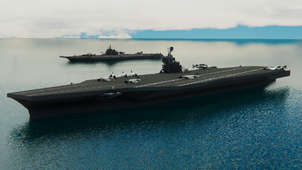
Defeat for the Arcadians was total on land, but at sea, the North Fleet was bloodthirsty for revenge. Steaming north at full speed, an Arkadii-Soyuz Carrier, eight Natalia-Class battleships, seventy torpedo boats, and OPV Missile boats began heading for the much smaller TF17, which could only now muster five battleships, after being reinforced by two Nautilane Morsers and their six destroyer escorts. Even worse, the Central Fleet, fully equipped with nearly the same number of ships, was en route to intercept the smaller IUF TF15, which was no match for their firepower, and it would only be a matter of time before they linked up with the North Fleet and created an unstoppable force of over a dozen battleships and 100+ support vessels, not to mention two carriers full of first-rate fighters. The Fort Grace and Emperor Zeroth scrambled every available jet, stretching their numbers thin for maximum dispersion of anti-ship capability, and headed for the North Fleet. The forty or so Arkadian YaV-39 fighters posed a great threat to the strike package, and the Zokesians knew they would have to defeat them in the air if they wanted to strike the ships without horrendous losses. The massive strike package of 82 F-52C Kargadans, all loaded to the max with fuel and Kaliber cruise missiles, lumbered twoard the fleet. 30 Kaminari and 10 UIF Kargadans followed behind with air-to-air loadouts, hoping the Arcadians would take the bait and launch an intercept of the seemingly defenseless strike force.And take the bait they did. The 42 Yav-39s were detected at a range of 35 miles from the strike package, and the covering fighters lit full afterburner to overtake their slower comrades and intercept before it was too late. The dogfight proved short but decisive - with only a few of the forty-plus Arcadian jets surviving, bullet-filled and damaged beyond repair as they limped back to their carriers. Only 5 Kargadans were lost, and the strike package now had the freedom to unleash hell on the ships below. From the previous engagement with the North fleet they knew the strategy required to take out these behemoths of steel, evade the screening torpedo boats and eliminate them en masse. Wave after wave of Kargadans screamed through the anti-air, firing their missiles and breaking off, dodging one another and the streams of blazing red CIWS from the ships below. The fleet squirmed and turned left and right, crisscrossing in a general panic, as missile after missile smashed home into battleships, torpedo boats, and missile boats. Their destruction was near total and the Zokesians showed no quarter, eliminated the lightly armored torpedo boats with Ebbs and pummeling the battleships with Kalibers untill their shattered hulls began to slip beneath the waves. Only seven of the eight Natalia-class battleships made it out alive, some damaged, some not - only to face the firepower of the TF17's five Morser Class battleships arcing down from extreme range just over the horizon. Gearing-Class Laveskan destroyers laid screens in front of the Morsers, taking heavy fire from the Arcadian ships and three were lost, but not before three of the Arcadian Natalias were put out of action. The remaining battleships turned tail and began to run for the Arcadian coastline.
Following the strike package, forty F-52C Kargadans from 6th Marine Air Group, freshly landed at their new home in NAS North Point, took off in search of the Center Fleet. Upon locating them, the Marine pilots took out another three dozen torpedo boats, OPVs, and a Natalia battleship. One flight, commanded by Krobin Yolds, looked out their port wing to see an Arkadii-Soyuz carrier steaming toward home. Diving in and firing their missiles, they watched as the big ship exploded in a fireball, her stern lifting out of the water at a ninety degree angle before crashing down and slowly sinking below the waves. The surviving Arcadian ships, once the potential to be the most fearsome fleet on kerbin, was running for their home ports in Arcadia. The battle had been decisive.
Outcome and Legacy
In 180 air-to-ground and 140 air-to-air sorties, Zokesian and UIF fighters had accounted for four battleships, 110 torpedo boats, ten OPVs, an arkadii-soyuz carrier, and over 110 Arcadian fighters. they had suffered just 20 fighters lost in the process. North Point was securely in UIF hands once again and the pride of the Arcadian navy had been broken. The Zokesians had lost one battleship and one damaged, and the Laveskans had lost three destroyers.
The naval victory at North Point succeeded in freeing the island of Arcadian occupation and established a foothold in the west for the Reclamation forces to stage a final liberation of mainland Aenia. The once powerful Arcadian fleets were destroyed and their remnants now interred in Crytil where they would see limited use in the future. The battle also provided John Kallan Kurrman, Zokesian president, a major victory after nearly a decade of civil war, depression, and strife, and the Stahlsieg were able to normalize relations with Zokesia following their "black deal" assisting the Zokesians with the invasion, and the Tau sea was once again opened to trade.

